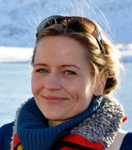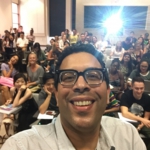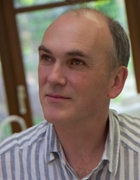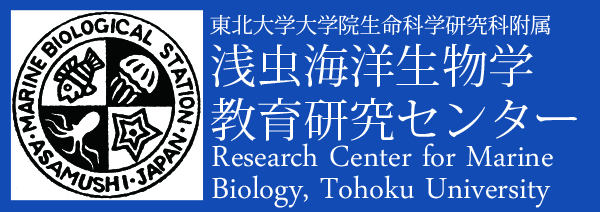We are delighted to announce that the Shinkishi Hatai International Marine
Biology Course 2017 will be held at the Research Center for Marine Biology
(RCMB), Tohoku University, Asamushi, Aomori, Japan from 5th–13th July 2017.
Who is Shinkishi Hatai?
Overview
A marine biology station is the ideal environment to observe live marine organisms and to begin studying marine biology. The marine biology course held at our marine biology station, RCMB, on the coast of Mutsu Bay, provides hands-on experience in handling organisms (echinoderms and ascidians) and exploring the often-overlooked invertebrate taxa living in the sand interstices (meiobenthos). The first half of the course will introduce the participants to three fields, developmental biology of echinoderms, developmental biology of ascidians, and meiobenthology. In the latter half of the course, participants will conduct projects supervised by instructors of each field, and their results will be presented on the last day. Specific projects will be arranged prior to the course.
Instructors & Projects
Course in Meiobenthology


Instructors: Drs.Katrine Worsaae(Department of Biology, University of Copenhagen) & Shinta Fujimoto
(RCMB)
Project detail: The marine environment harbours diverse organisms with
various modes of life. This course aims to introduce a group of organisms
known as meiobenthos to the participants. Meiobenthos is often overlooked
due to its small body size (mostly less than a millimetre), but contrary
to this state, its biodiversity and biomass are non-negligible and is stimulating
studies on evolution and ecology. The one day introductory course (6th
July) focuses on acquiring the basic methods of how to collect, extract,
find and observe these fascinating organisms around RCMB. All common extraction
techniques (decantation, freshwater shock, bubble-and-blot, floatation,
MgCl2 anaesthesia, and seawater ice) will be demonstrated. The advanced
course (10th & 11th July) will expand the sampling to more localities
with different environment and try to grasp a better picture of diversity
and also learn how to identify them. For the advanced course, we welcome
participants’ requests on what they are especially interested in (e.g.
specific organism, field of study, and on). Upon request, we may be able
to prepare a mini-project that the participant would be interested in working
on.
Beakers vs Breakers: Mechanisms of Development and Protection in Sea Urchin Embryos

Instructor: Dr.Amro Hamdoun(Cell and Developmental Biology, Scrips Institute of Oceanography)
Supporting RCMB staff: Drs. Takuya Minokawa and Keiichiro Kyozuka
Project detail: Course Description: Sea urchins have been studied for nearly
150 years to understand mechanisms of fertilization and early development.
Their eggs and sperm can easily be obtained in large amounts, and combined
to produce a virtually endless supply of optically transparent embryos
ideal for observation and manipulation of development. Moreover, several
species of sea urchins have fully sequenced genomes, making them amenable
to modern reverse genetic approaches. The goal of this short-course is
to introduce students to the basic principles of working with sea urchins,
including isolation of egg and sperm, fertilization, microinjection, embryo
culture, cell labeling and imaging. We will use the local sea urchin, Temnopleurus
hardwickii, to explore how the embryo is adapted to ensure fidelity of
development in the real world, including mechanisms that ensure isolation
of the egg and sperm of each species, and those that protect the embryo
against harmful toxicants. We will also use simple cell markers to label
primordial germ cells, which are the precursors to egg and sperm, and examine
their formation and migration. By the end of the course students should
be sufficiently familiar with sea urchins to conduct and analyze simple
environmental or genetic perturbations of development.
July 7th: Morning- Introduction to the course, primer on sea urchin development
and overview of the basic principles of light microscopy necessary for
observation of development. Afternoon- Fertilization and embryology lab.
Evening- Selection of student projects. Discussion of CRISPR-CAS9 in sea
urchins.
July 10th: Morning- Protective mechanisms of development. ABC transporters.
Afternoon- Cell labeling and microinjection lab. Analysis of transporter
activity with small molecule dyes, overexpression of transporters, and
labeling of cell compartments. Evening ? Student Projects.
July 11th : Morning- Introduction to formation and migration of the primordial
germ cell lineage.
Afternoon- Labeling of the primordial germ cell lineage, observation of
epithelial to mesenchymal transitions. Evening ? Student Projects.
July 12th: Student projects.
Developmental Biology of Ascidians

Instructor: Dr.Alexander McDougall(Developmental Biology Laboratory, Villefranche-sur-mer)
Supporting RCMB staff: Drs. Gaku Kumano, Ayaki Nakamoto, and Keiichiro
Kyozuka
Project detail:photo_AM.jpg
Lecture Section (July 8; Introductory course): Introduction to ascidian.
Diversity of ascidian species, Phylogeny, anatomy, life cycles and early
development.
Laboratory Section:
Day 1(July 8; Introductory course) is animal and gamete handling.
Preparing eggs and sperm and dechorionating eggs.
Observation from fertilization to gastrulation in ascidians.
Day 2 (July 10) is Experimental
Do ascidian embryos twin and is unequal cell division cell autonomous?
Cell isolation experiments and observation of division pattern of the isolated
blastomeres
Day 3 (July 11) is Experimental.
How is cell division time controlled so that a 24‐cell stage embryo is
produced?
Test a hypothesis that beta-catenin causes cell cycle asynchrony.
Keynote Lecture
Marine Biological Stations: Yesterday, Today and Tomorrow
Lecturer: Dr. Hoshi Motonori (Professor Emeritus, Tokyo Institute of Technology)MH-photo.JPG
A brief history of marine biological stations as important sites for the
progress of biology will be overviewed and the near future of the stations
will be discussed.
Venue
Research Center for Marine Biology, Tohoku University Click here for detail
Schedule
5th July:
Registration
15:30 Keynote lecture by Dr. M. Hoshi
18:00 Welcome reception
6th July: “Course in Meiobenthology” by Drs. K. Worsaae and S. Fujimoto
Lecture & lab work
7th July: “Beakers vs Breakers: Mechanisms of Development and Protection
in Sea Urchin Embryos” by Dr. A. Hamdoun
Lecture & lab work
8th July: “Handling of Gametes and Observation of Ascidian Embryos” by
Dr. A. McDougall
Lecture & lab work
9th July: Excursion and preparation for individual projects
10–11th July: Advanced courses for each project
12th July:
15:00 Presentations of each project
18:00 Farewell party
13th July: Leaving Asamushi
Qualification
shimbc2.jpgThe course is open for undergraduate and graduate students (approx.
15 in total) from any institute, who major in or have an interest in biology
and related fields. If the number of applicants exceeds our hosting capacity,
we may have to decline applications. Experience in handling marine animals
is not necessary, but welcome. Accommodations and meals are available at
a reasonable rate at the center’s dormitory (Click here for detail). We are unable to support your travel expenses; however, we will work
to assist you in obtaining travel subsidies.
Registration
1. Please send an e-mail to the following address with your intention to
participate in the course and the specific project you want to participate
in by 31st March 2017. An early notice of your intention to participate
will optimize preparing for individual projects.
E-mail address: shimbc2017(at)grp.tohoku.ac.jp [Please change (at) to @]
2. When we receive your e-mail, we will send an application form with additional
information about the course, accommodations, and so on.
Organizing committee
Dr. Keiichiro Kyozuka (Chair person)
Dr. Gaku Kumano
Dr. Shinta Fujimoto
This program is supported by the Ministry of Education, Culture, Sports,
Science and Technology in Japan.
